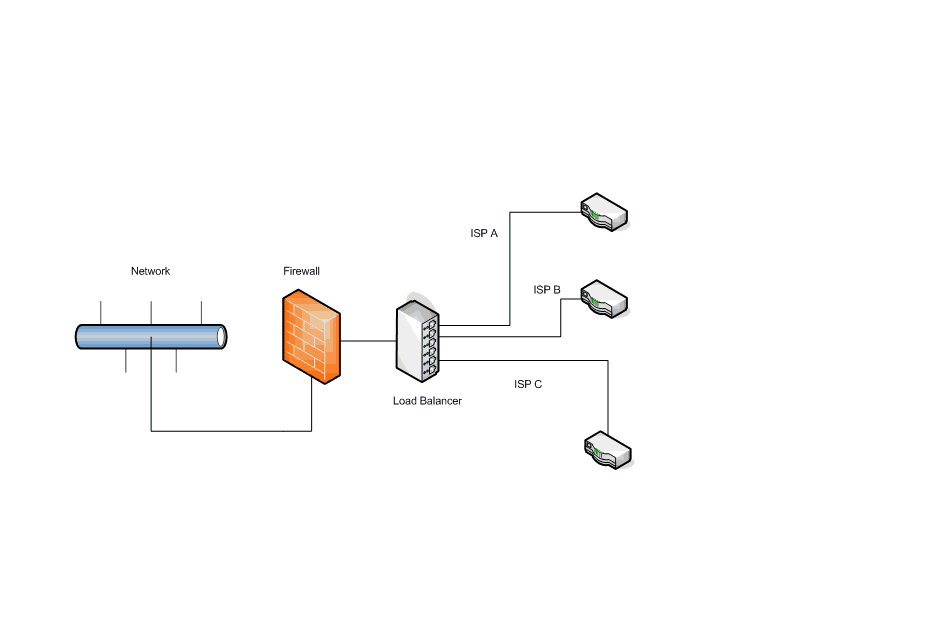Introduction to WAN Load Balancers Monitoring
Since load balancers are active devices that can be included in the design of a WAN, the question arises: Should we adapt our monitoring scheme to include something that could be called Load Balancer Monitoring?
To answer this question we can assume that WAN monitoring is based on the following fact: the behaviour of communication links directly affects the performance of applications and therefore the entire platform.
It is clear then the need to monitor the links, but to perform this monitoring requires knowledge of the entire associated architecture.
Architecture that usually consists of elements such as active devices (routers, firewall, modems, etc.), communication protocols, the technology used by the links contracted to a service provider, the applications and services that use these links, etc..
Based on this architecture, WAN Load Balancers Monitoring has the following objectives:
- Monitoring of the active teams involved with the traffic that passes through each link.
- Measurement of bandwidth consumed and available.
- Evaluation of the levels of services contracted to a specific supplier.
- Identification of bandwidth consumption patterns; which application, which protocol, which user consumes what percentage of bandwidth.
- Monitoring of error conditions such as number of retransmissions, packet loss, increased latency, etc.
On the other hand, WAN Load Balancers Monitoring has required adapting to the evolution of technology.
All the elements that have influenced the evolution of WAN platforms have brought challenges that WAN monitoring has had to face. For example, we can mention the trend towards the cloud, the networks defined by software, the consolidation of a model centred on the Internet, the variety in the types of services provided by specialized companies or the development of administrative capacities in the allocation of bandwidth.
The reader interested in these challenges may find interesting this article on the challenges assumed by the implications of SDN and this other related to the Internet-centred model.
At this point, the relationship between WAN Load balancers Monitoring and the architecture of the network to be monitored is clear.
WAN Load Balancers Monitoring
One of the elements that have emerged to improve the performance of communications links and that can form part of the architecture of WAN design are just load balancers.
The operation of the same part of establishing a process through which the outgoing traffic of a network is distributed or balanced between multiple links, which can be provided by different service providers and can be implemented by different technologies.
Let’s consider this scheme as an example:

Diagram 1, example of installation with a balancer and three links from three different suppliers
The definition that some authors use when they indicate that a load balancer is the result of the blissful crossing between a switch and a router is nice.
However, this idea is a bit short given that some balancers have actually been covering Firewall, Proxy, security and even offering QoS implementations.
In any case we can say that, in their basic activity, the balancers offer the following advantages:
- They establish a redundancy scheme in case of failure between the different links.
- They define an efficient scheme of utilization of the capacities of each link.
- They offer administrators a flexible working scheme, where they can choose the best balance configuration based on certain link conditions such as availability, performance, latency, and cost or based on traffic characteristics such as protocol, origin, priority, etc.
The balancing protocols that apply these devices usually do not balance package by package but are often used as a work item ¨ the connections¨.
It is then understood that transmissions are carried out in full by the link assigned at the beginning, regardless of the load in number of packets or total bytes that such transmission involves.
For example, let’s consider the diagram above and assume that we have 10 different connections to transmit, and let’s also assume that each link has a different capacity. After the balancer applies its balancing protocol, we can end up with 6 connections for ISP 1, 3 connections for ISP 2 and 1 connection for ISP 3.

Description It is diagram 1 modified to show capabilities of each link and illustrate the example with 10 transmissions
Of course not everything is light as far as balancers are concerned; their detractors tend to focus their criticism on the consequences of the fact that balancers are other ¨boxes¨ that must be integrated into the WAN platform.
This new box, critics say, offers a central point of failure, makes the platform more complex, and requires administrators to use a proprietary platform for administration.
The reader interested in these negative aspects can review an interesting article here.
Load Balancer Monitoring
Those who are determined to use a load balancer or already have one in their WAN solution must face a challenge in terms of platform visibility.
The problem of visibility of the balancers is that, being a box, monitoring them only offers visibility on the traffic that passes through them and on the performance of the balancer itself.
Monitoring the balancers will not provide visibility over the last mile of the links that connect to it, so the monitoring of the balancers must be integrated into a broader WAN monitoring scheme.
On the other hand, there is the level of abstraction offered by this equipment; when balancing the connections between the links, in some way all the links they handle are being integrated in another non-physical general link that contains the previous ones.
And although they add up the bandwidths of each link, to obtain the total available bandwidth, for example, it is true that the administrative consoles of the balancers present an overview.
In fact, when we manage these teams naturally there is a tendency to understand all the links associated with a balancer as a whole.
Taking this into consideration it is sensible to think that the monitoring traditionally done, i.e. link-to-link monitoring falls short.
So the monitoring software must offer the possibility to monitor each link but at the same time it must offer users the expected group vision.
Said which, we are in the point to be able to specify as requirements to carry out the efficient monitoring of links connected to a load balancer:
- Monitor load balancers as an active network device. We can use for example Pandora FMS SNMP monitoring to collect, store and analyse information about the balancers operation.
- Perform monitoring of each link individually, determining for example variables such as latency, number of lost packets, compliance with contracted service levels, bandwidth, application list, list of users, list of protocols, and so on.
In this link the reader will be able to find information associated to the bandwidth calculation made by Pandora FMS.
- Adapt traffic identification to the way the balancer establishes balancing schemes. For example, if we have a balancer it uses the IP addresses of origin and destination in addition to the identification of the ports, because it would be very useful if we could adapt our monitoring platform so that it carries out this same type of identification.
- To form a group with the links connected to a load balancer in order to obtain statistics of the group.
- Establish well integrated monitoring and optimization processes between the monitoring tool and the traffic balancer management tools.
At the end of the day the idea is to adapt our WAN monitoring scheme to facilitate the decision making of the configuration of the balancing scheme, support the execution of growth plans in terms of links and bandwidths and evaluate the service provided by each provider, all this in light of the comprehensive monitoring of our platform and applications.
Of course, we invite you to know all the potential of Pandora FMS, especially in the world of LAN and WAN networks, visiting this section of our website.
We also encourage you to share your experiences or concerns regarding WAN load balancers and monitoring, leaving us your comments.




















